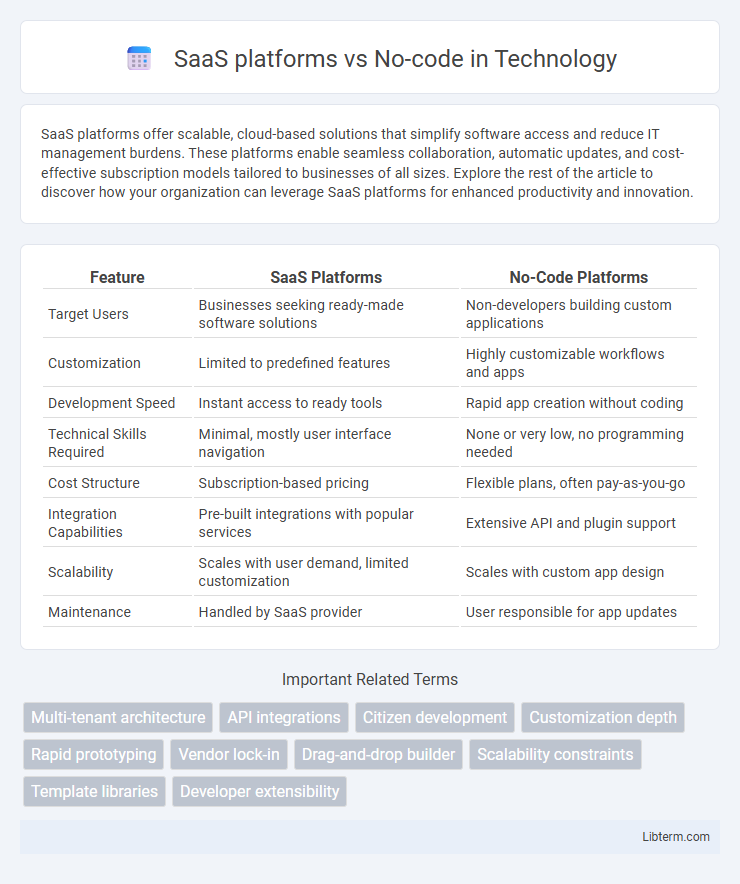SaaS platforms offer scalable, cloud-based solutions that simplify software access and reduce IT management burdens. These platforms enable seamless collaboration, automatic updates, and cost-effective subscription models tailored to businesses of all sizes. Explore the rest of the article to discover how your organization can leverage SaaS platforms for enhanced productivity and innovation.
Table of Comparison
| Feature | SaaS Platforms | No-Code Platforms |
|---|---|---|
| Target Users | Businesses seeking ready-made software solutions | Non-developers building custom applications |
| Customization | Limited to predefined features | Highly customizable workflows and apps |
| Development Speed | Instant access to ready tools | Rapid app creation without coding |
| Technical Skills Required | Minimal, mostly user interface navigation | None or very low, no programming needed |
| Cost Structure | Subscription-based pricing | Flexible plans, often pay-as-you-go |
| Integration Capabilities | Pre-built integrations with popular services | Extensive API and plugin support |
| Scalability | Scales with user demand, limited customization | Scales with custom app design |
| Maintenance | Handled by SaaS provider | User responsible for app updates |
Introduction to SaaS Platforms and No-Code Tools
SaaS platforms deliver cloud-based software applications accessible via the internet, enabling seamless scalability, automatic updates, and reduced infrastructure costs for businesses. No-code tools empower users to build software applications, websites, and automations without traditional programming skills by using visual development interfaces, accelerating development cycles. Combining SaaS and no-code technology enhances digital transformation efforts, allowing organizations to rapidly deploy customizable solutions with minimal technical expertise.
Key Differences Between SaaS and No-Code Solutions
SaaS platforms deliver fully developed software applications hosted online, offering users ready-to-use tools without customization complexity. No-code solutions empower users to build and customize apps through visual interfaces without programming knowledge, enabling tailored functionality. Key differences include SaaS's fixed features with subscription access versus no-code's flexible app creation for specific business needs.
Use Cases: When to Choose SaaS vs No-Code
SaaS platforms excel in delivering pre-built solutions for common business needs like CRM, accounting, and project management, ensuring reliability and scalability for enterprises. No-code platforms empower users to create custom applications tailored to unique workflows and niche processes without extensive programming knowledge, ideal for rapid prototyping and internal automation. Choose SaaS when requiring robust, industry-standard tools with minimal setup, and opt for no-code when flexibility and customization are paramount for specific operational challenges.
Scalability: Comparing Growth Potential
SaaS platforms offer robust scalability by supporting increased user loads and complex integrations, making them ideal for businesses anticipating rapid expansion. No-code solutions provide ease of use and quick deployment but often face limitations in handling large-scale operations or extensive customization. Choosing between SaaS and no-code depends on the required growth trajectory and technical complexity of the project.
Customization and Flexibility
SaaS platforms offer predefined features and limited customization, making them ideal for businesses seeking quick deployment with standard solutions. No-code platforms provide greater flexibility by enabling users to create tailored applications without programming knowledge, allowing more precise alignment with unique workflows and processes. Customization in no-code environments often extends to visual design, data integration, and automation, surpassing the rigid frameworks typical of traditional SaaS offerings.
Integration Capabilities
SaaS platforms typically offer robust integration capabilities through extensive APIs and native connectors, facilitating seamless data exchange with enterprise systems and third-party applications. No-code platforms prioritize user-friendly integration tools like drag-and-drop connectors and pre-built app integrations, enabling non-technical users to create workflows without writing code. Both solutions support automation and scalability, but SaaS platforms often provide more customizable and complex integration options suitable for advanced IT environments.
Cost Considerations
SaaS platforms typically involve subscription fees that scale with user numbers and feature access, impacting long-term operational budgets. No-code solutions reduce development costs by minimizing the need for specialized coding skills, but may include tiered pricing based on usage limits or premium integrations. Evaluating total cost of ownership requires analyzing upfront expenses, scalability fees, and potential costs for customization or support in each option.
Technical Skills Required
SaaS platforms typically require users to have intermediate technical skills, including basic programming knowledge or familiarity with API integrations to customize and extend functionality. No-code platforms minimize the need for traditional coding by providing visual development tools, enabling users without technical backgrounds to build and deploy applications through drag-and-drop interfaces. While SaaS offers robust features for developers, no-code lowers the entry barrier, accelerating development for business users with limited technical expertise.
Security and Compliance
SaaS platforms provide robust security frameworks with built-in compliance certifications such as GDPR, HIPAA, and SOC 2, ensuring data protection and regulatory adherence. No-code platforms often rely on third-party SaaS infrastructure, which can introduce variable security controls and compliance risks depending on the vendor's maturity and policies. Organizations seeking stringent data governance should evaluate each platform's encryption standards, access controls, and audit capabilities before adoption.
Future Trends in SaaS and No-Code Platforms
Future trends in SaaS platforms emphasize increased AI integration, enabling enhanced automation and personalized user experiences. No-code platforms are evolving with advanced drag-and-drop interfaces and expanding API connectivity, empowering non-developers to create complex applications rapidly. The convergence of SaaS and no-code technologies will drive scalable, customizable solutions, accelerating digital transformation across industries.
SaaS platforms Infographic

 libterm.com
libterm.com